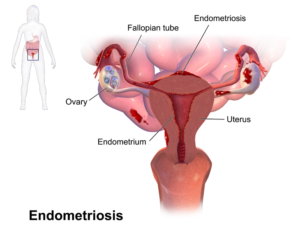For women in their childbearing years who are suffering from endometriosis, resection surgery can greatly reduce pain while protecting reproductive organs. Minimally invasive surgeries are especially effective at relieving pelvic pain in a safe, efficient manner.

What is it?
The endometrium is the layer of tissue that lines the inside of the uterus and sheds during menstruation. In some women, similar endometrial tissue can be found growing outside of the uterus within the pelvic cavity. This condition is known as endometriosis and can have no effect on a patient’s life or be extremely painful. A robotic endometriosis resection is a procedure aiming to preserve the function of the ovaries and uterus while relieving the patient of any symptoms. The surgery will be performed laparoscopically and allow for the surgeon to remove some of the abnormal tissue. Symptoms are likely to return after a few years since this surgery does not cure the condition, but it significantly relieves pain and preserves the childbearing function of the patient’s organs.
How to Prepare
Surgeons will likely ask patients to refrain from eating or drinking after midnight the night before the procedure. A special medication may be given to patients to help clear their colon. General anesthesia will be used for the procedure, but patients can usually leave the same day they receive surgery. Make preparations at home for a longer recovery. Recovery times vary greatly, but persistent pain and low-energy levels are common side effects after surgery.
What happens during the process?
Small incisions will be made in the abdomen where the surgeon will insert the various laparoscopic tools. Using robotic arms controlled from a console, the surgeon can then remove the tissues that are causing pain. Sometimes the tissues may be deeply embedded in the organs, so the surgeon may only be able to remove some of the tissue. This process can take anywhere from one to four hours.
Risks and Complications
- Excessive bleeding
- Damage to the bladder or other organs
- Infection
- Formation of scar tissue
- Childbirth complications
Disclaimer:
All GlobeHealer Site content, including graphics, images, logos, and text, among other materials on the site are for educational purposes only. This content is not intended to be a substitute for professional medical advice, and you should always contact your physician or qualified health provider for information regarding your health. Information on this site regarding the overview, diagnosis, and treatment of any kind should be looked at, in addition to the advice and information of your health care professional. Do not disregard medical advice or delay seeking treatment or medical advice due to information found on the GlobeHealer site.
If there is even the possibility that you may have a medical emergency, seek treatment, call your doctor, or call your local emergency telephone number immediately. GlobeHealer does not endorse being the first line of communication in case of emergency and does not endorse any specific test, physician, facility, product, procedure, opinion, or other information that is or may be mentioned on this site or affiliated entities. Reliance of any and all information provided by GlobeHealer, its employees, affiliations, others appearing on the Site under the invitation of GlobeHealer, or visitors of the site is solely at your own risk and is not the responsibility of GlobeHealer.
Image Source:
https://upload.wikimedia.org/wikipedia/commons/d/d5/Blausen_0349_Endometriosis.png
